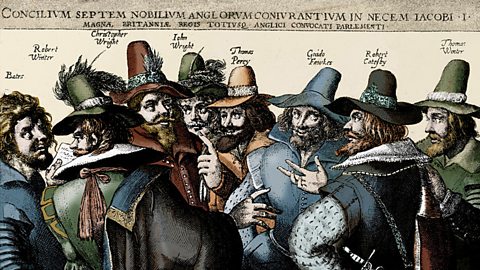The Gunpowder Plotters, 1605
In 1603, King James VI of Scotland also became King James I of England. James I was a Protestant, but many Catholics hoped that they would be able to worship more freely under his reign. However, in 1604 James I introduced new laws against Catholics. This meant they were treated more harshly than before.
- James I believed that having two religions in England would cause disunity A lack of unity within a community or group.
- Protestantism had been the official religion in England since the 1559 Act of Uniformity, passed by Elizabeth I, who had been excommunicateOfficially expel someone from the Church and stop them taking part in the services of the Church. by the Pope in 1570.
- The Pope had then called upon loyal Catholics to try and remove Elizabeth from the throne.
The Gunpowder Plot
- In 1605 a group of Catholics led by Robert Catesby planned to blow up the Houses of Parliament to kill the king and replace him with a Catholic monarch.
- Guy Fawkes, one of the 13 plotters, was given the job of filling the vault below the Houses of Parliament with about 36 barrels of gunpowder.
- However, an anonymous letter warning about the danger was shown to Robert Cecil, the king's chief minister.
- The vaults below the Houses of Parliament were searched and Fawkes was found and arrested.
- He was then tortured at the Tower of London until he shared the names of the other plotters and forced to sign a confession.
- The other plotters managed to escape. However, they were later caught by government soldiers and some, including Catesby, were killed in the fighting that followed.

Punishment
Guy Fawkes and the plotters who survived the fighting were found guilty of treason and sentenced to be hanged, drawn and quartered. This meant that they were hanged but were cut down just before the point of death. They then had their bodies cut open and their intestines pulled out. Finally, their limbs and head were cut off. The beginning of the 17th century was a time of political and religious unrest, and this harsh punishment was used to deterTo put someone off doing something. any future rebellions by Catholics.
Legal changes
After the Gunpowder Plot, James I passed stricter measures against Catholics. In 1606, the Popish Recusants Act required Catholics to swear an oath of allegiance to the monarch and they were forced to participate in Church services or pay a fine. Over the following centuries, Catholics were restricted from owning land and becoming MPsMembers of Parliament. They were not permitted to vote in elections until 1829.